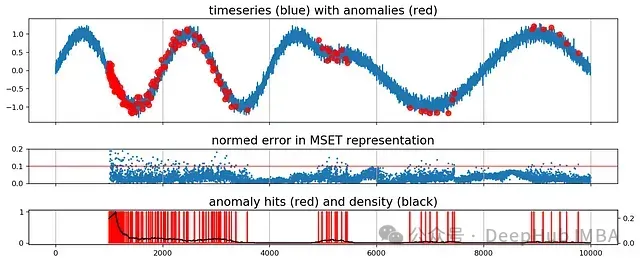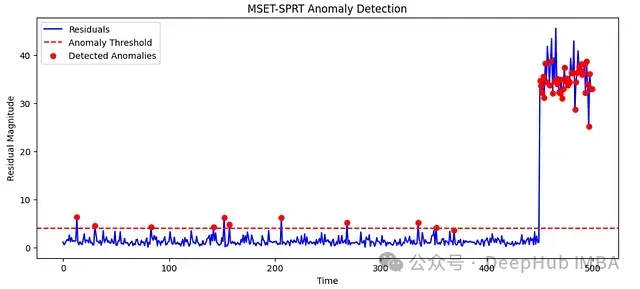在异常检测领域,尤其针对工业机械、核反应堆和网络安全等复杂系统,传统方法往往难以有效处理高维度且相互关联的数据流。多元状态估计技术(MSET) 与序贯概率比检验(SPRT) 的组合方法在此类场景中展现出显著优势。
MSET-SPRT是一种结合机器学习状态估计与统计假设检验的混合技术框架,通过其高精度和稳健性,被广泛应用于关键任务系统的监控与分析。该方法能够实时识别系统行为的微小偏差,为预防性维护和异常事件预警提供可靠依据。

MSET-SPRT理论基础
多元状态估计技术(MSET)原理
MSET作为一种非参数非线性回归技术,通过历史观测数据构建系统正常状态模型。其核心工作机制包括:
建立包含历史正常系统状态的记忆矩阵,作为参考基准;利用学习到的历史状态间关系计算加权组合,从而估计当前系统的预期状态;通过对比观测值与估计值,计算系统行为偏差,为异常检测提供基础指标。
序贯概率比检验(SPRT)方法
SPRT是一种基于统计推断的序贯假设检验方法,专用于确定系统行为偏差是否具有统计显著性。其主要功能为:
持续评估残差误差(实际观测值与模型估计值之间的差异),并根据预设的统计模型进行假设检验;当检测到的偏差超过统计置信阈值时,系统能够及时发出预警信号,同时控制虚警率在可接受范围内。
MSET-SPRT框架通过上述两种技术的协同作用,为多元数据异常检测提供了准确且高效的解决方案,特别适用于高维度、高相关性的时间序列数据分析。
Python实现MSET-SPRT异常检测
下面通过一个精简的示例来演示MSET-SPRT方法在Python中的实现过程。
导入必要的库
生成模拟数据集
构建一个多元正态分布数据集,用于模拟正常运行状态下的系统行为:
实现MSET算法
采用基于加权最近邻的方法实现MSET算法,用于估计系统的预期行为:
初始化MSET模型,将正常运行数据作为记忆矩阵:
计算残差
计算实际观测值与MSET估计值之间的残差,作为异常检测的基础:
应用SPRT进行异常检测
基于似然比检验原理实现SPRT算法,用于判定残差是否表示异常状态:
结果分析与解释

图中数据可视化结果展示了MSET-SPRT方法的异常检测效果:
蓝色曲线表示系统状态残差时间序列,反映了实际观测值与估计值之间的偏差大小;红色虚线标示出异常检测阈值,该阈值基于正常运行数据的统计特性计算得出;红色标记点则代表被SPRT算法判定为异常的时间点,这些点的残差值显著高于正常波动范围。
分析结果表明,MSET-SPRT方法能够有效区分正常系统波动与异常行为,提供了一种可靠的多元时间序列异常检测方案。该方法特别适用于需要高精度异常检测的工业监控、设备健康管理和网络安全等领域。
文章来自:51CTO

